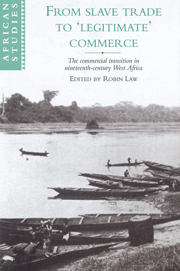 From Slave Trade to 'Legitimate' Commerce
From Slave Trade to 'Legitimate' Commerce Book contents
- Frontmatter
- Contents
- List of contributors
- List of abbreviations
- Introduction
- 1 The initial ‘crisis of adaptation’: the impact of British abolition on the Atlantic slave trade in West Africa, 1808–1820
- 2 The West African palm oil trade in the nineteenth century and the ‘crisis of adaptation’
- 3 The compatibility of the slave and palm oil trades in Dahomey, 1818–1858
- 4 Between abolition and Jihad: the Asante response to the ending of the Atlantic slave trade, 1807–1896
- 5 Plantations and labour in the south-east Gold Coast from the late eighteenth to the mid nineteenth century
- 6 Owners, slaves and the struggle for labour in the commercial transition at Lagos
- 7 Slaves, Igbo women and palm oil in the nineteenth century
- 8 ‘Legitimate’ trade and gender relations in Yorubaland and Dahomey
- 9 In search of a desert-edge perspective: the Sahara-Sahel and the Atlantic trade, c. 1815–1900
- 10 The ‘New International Economic Order’ in the nineteenth century: Britain's first Development Plan for Africa
- Appendix The ‘crisis of adaptation’: a bibliography
- Index
4 - Between abolition and Jihad: the Asante response to the ending of the Atlantic slave trade, 1807–1896
Published online by Cambridge University Press: 21 September 2009
- Frontmatter
- Contents
- List of contributors
- List of abbreviations
- Introduction
- 1 The initial ‘crisis of adaptation’: the impact of British abolition on the Atlantic slave trade in West Africa, 1808–1820
- 2 The West African palm oil trade in the nineteenth century and the ‘crisis of adaptation’
- 3 The compatibility of the slave and palm oil trades in Dahomey, 1818–1858
- 4 Between abolition and Jihad: the Asante response to the ending of the Atlantic slave trade, 1807–1896
- 5 Plantations and labour in the south-east Gold Coast from the late eighteenth to the mid nineteenth century
- 6 Owners, slaves and the struggle for labour in the commercial transition at Lagos
- 7 Slaves, Igbo women and palm oil in the nineteenth century
- 8 ‘Legitimate’ trade and gender relations in Yorubaland and Dahomey
- 9 In search of a desert-edge perspective: the Sahara-Sahel and the Atlantic trade, c. 1815–1900
- 10 The ‘New International Economic Order’ in the nineteenth century: Britain's first Development Plan for Africa
- Appendix The ‘crisis of adaptation’: a bibliography
- Index
Summary
In a series of military campaigns between 1807 and 1816, Asante, the major supplier of slaves for export from the Gold Coast, at last succeeded in overpowering the Fante ‘middlemen’ states and extending its political domination to virtually the whole coast. But while Asante had been thus preparing to eliminate or minimize the middlemen's rake-off from Asante slave sales to the European forts, the latter had been closing their doors to human commodities. The largest slave-trading nation, Britain, withdrew from the trade in 1807. While the war in Europe lasted, the British navy ensured that the other European powers with a permanent presence on the Gold Coast, the Netherlands and Denmark, had little trade of any sort with West Africa. When it ended Britain extracted the prohibition of Dutch nationals from trading in slaves as a condition of diplomatic recognition of the post-Napoleonic Dutch regime. As the Danish authorities had already banned their merchants from participation, since 1803, within little more than a decade every fort on the Gold Coast had officially closed to slave buying. The restoration of peace in Europe made it much easier for coastal merchants to find buyers for slaves, including those sold to them by Asantes. Between 1816 and 1818 there was an intense revival of the traffic. This roughly coincided with the tenure of H. Daendels as Dutch Governor-General at Elmina. British sources accused the Dutch of connivance, while the ships themselves were Spanish and Portuguese, some with American owners.
- Type
- Chapter
- Information
- From Slave Trade to 'Legitimate' CommerceThe Commercial Transition in Nineteenth-Century West Africa, pp. 93 - 118Publisher: Cambridge University PressPrint publication year: 1995
- 10
- Cited by


